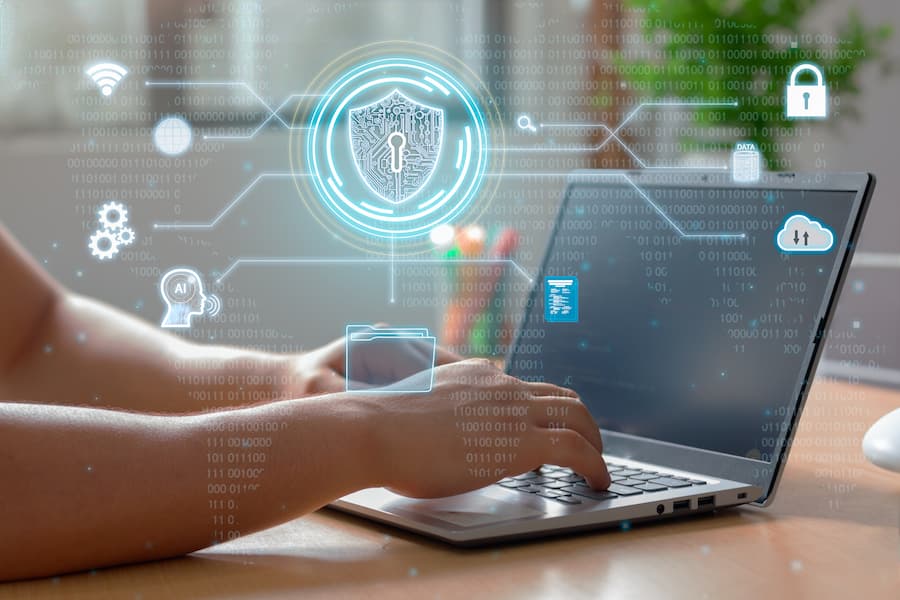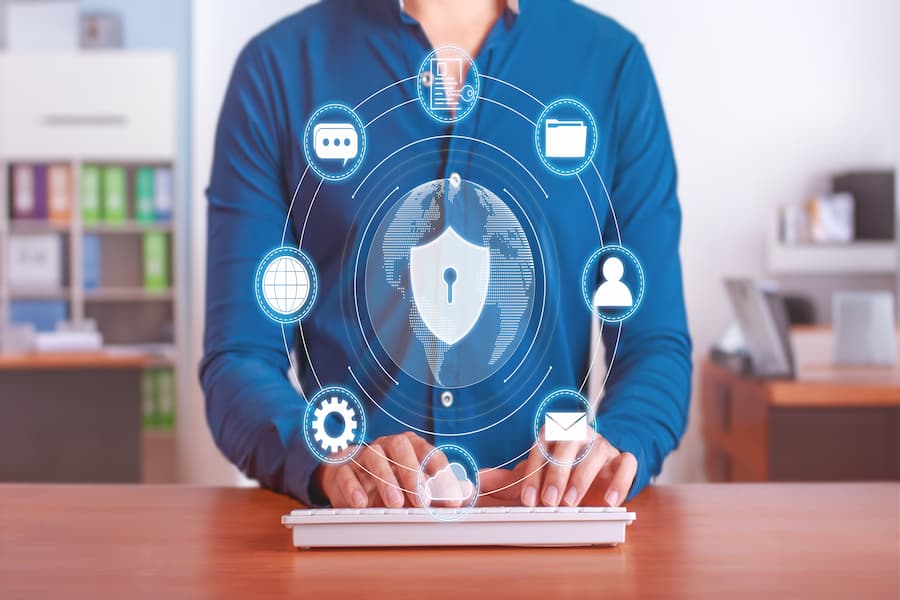For business cybersecurity is more crucial than ever. Cyber attacks can have devastating effects on businesses, leading to financial losses and damage to reputation. For Michigan businesses, the challenges are unique due to the state’s diverse economic landscape, including industries like manufacturing, healthcare, and automotive.
Cybersecurity best practices are essential for safeguarding sensitive information and preventing unauthorized access. By understanding and implementing these practices, businesses can reduce security risks and protect their assets. This article aims to provide Michigan businesses with a comprehensive guide to cybersecurity, tailored to address their specific needs and threats.

Understanding Cybersecurity Threats
Common Cybersecurity Threats
Cyber threats are evolving rapidly. Among the most prevalent are phishing, malware, and ransomware. Phishing involves tricking individuals into providing confidential information, often through fake emails or websites. Malware refers to malicious software designed to disrupt, damage, or gain unauthorized access to computer systems. Ransomware is a type of malware that encrypts data and demands a ransom for its release.
Specific Threats to Michigan Businesses
Michigan businesses face unique cybersecurity challenges due to their industry-specific operations. For instance, the automotive sector is increasingly targeted due to its reliance on advanced technologies.
Similarly, healthcare providers must protect sensitive information like patient records, which are prime targets for hackers. Recent incidents, such as the attack on the Michigan State University network, highlight the importance of robust cybersecurity measures.
By understanding these localized threats, businesses can develop tailored strategies to mitigate risks.
Implementing Cybersecurity Policies
Developing a Cybersecurity Policy
Creating a cybersecurity policy is the first step toward protecting your business. This policy should outline the rules and procedures for safeguarding information and managing security risks. Start by identifying the assets that need protection, such as customer data and intellectual property. Next, define the roles and responsibilities of employees in maintaining cybersecurity.

Policy compliance is crucial. Without it, even the best-designed policies can fail. Ensure all employees understand and follow the policy. Regularly review and update the policy to address new threats and vulnerabilities.
Employee Training and Awareness
Employee training is essential for effective cybersecurity. Training programs should educate employees about the latest threats and best practices for avoiding them. This includes recognizing phishing attempts, using strong passwords, and securing their devices.
Regular awareness sessions can reinforce this training. These sessions can include workshops, seminars, and simulated attacks to test employee readiness. By fostering a culture of cybersecurity awareness, businesses can significantly reduce their vulnerability to attacks.
Access Control Measures
Access control is a fundamental aspect of cybersecurity. It involves restricting access to sensitive data and systems based on the user’s role within the organization. Implementing role-based access ensures that employees only have access to the information necessary for their job.
Multi-factor authentication (MFA) adds an extra layer of security. In addition to a password, MFA requires a second form of verification, such as a fingerprint or a code sent to a mobile device. This makes it much harder for unauthorized users to gain access to critical systems.
Data Protection Strategies
Protecting data is paramount. Data encryption is a powerful tool that converts data into a code to prevent unauthorized access. Encrypting sensitive information ensures that even if data is intercepted, it cannot be read without the encryption key.
Regular backups are also crucial. In case of a cyber attack, having up-to-date backups allows businesses to restore their data with minimal disruption. Store backups in a secure, offsite location to protect against physical and cyber threats.
By implementing these cybersecurity best practices, Michigan businesses can safeguard their operations and thrive in an increasingly digital world.
Cybersecurity Technologies and Tools
Antivirus and Anti-malware Software
In cybersecurity, antivirus and anti-malware software are fundamental. These tools are designed to detect, prevent, and remove malicious software from your organization’s systems. When choosing antivirus software, look for features like real-time scanning, automatic updates, and robust malware detection capabilities.
Some highly recommended products include Norton, Bitdefender, and McAfee. These solutions offer comprehensive protection against a wide range of cyber threats, ensuring that your devices and systems remain secure.
Firewalls and Network Security
Firewalls act as a barrier between your corporate network and potential threats from the internet. They monitor and control incoming and outgoing network traffic based on predetermined security rules. There are various types of firewalls, including hardware, software, and cloud-based solutions. Each type offers unique benefits and can be tailored to meet the specific needs of your business.
Best practices for network security include regularly updating firewall rules, conducting security audits, and segmenting networks to limit the spread of cyberattacks. Ensuring your firewall is properly configured and maintained can significantly reduce your organization’s vulnerability to cyber threats.
Intrusion Detection Systems (IDS)
Intrusion Detection Systems (IDS) play a critical role in monitoring your network for suspicious activity. These systems analyze traffic patterns and user behavior to detect potential threats. When IDS identifies unusual activity, it alerts your security team, allowing for a swift response.
The benefits of IDS include early detection of threats, improved incident response times, and enhanced visibility into your network’s security posture. Implementing IDS can help organizations of all sizes protect their networks and data from malicious actors.
Security Information and Event Management (SIEM)
Security Information and Event Management (SIEM) systems collect and analyze data from various sources within your network. This centralized approach provides a comprehensive view of your organization’s security environment, making it easier to identify and respond to threats. SIEM systems can correlate events across multiple devices, helping to detect complex attack patterns.
The importance of SIEM in threat detection cannot be overstated. By leveraging SIEM, businesses can gain insights into potential vulnerabilities and take proactive measures to mitigate risks.
Maintaining Cybersecurity
Regular Security Audits
Conducting regular security audits is essential for identifying and addressing security vulnerabilities. Audits help ensure that your cybersecurity practices are effective and up-to-date. They can be conducted internally by your IT team or externally by third-party experts. Internal audits provide ongoing monitoring, while external audits offer an unbiased assessment of your organization’s security posture.

The importance of audits lies in their ability to uncover hidden weaknesses and provide recommendations for improvement. Regular audits are a critical component of a robust cybersecurity strategy.
Keeping Software Updated
Keeping your software updated is one of the simplest yet most effective ways to protect against cyber threats. Patch management involves applying updates and patches to fix security vulnerabilities in your software. This process should be automated whenever possible to ensure timely updates.
Automated updates reduce the risk of human error and ensure that your systems are always protected against the latest threats. However, manual updates can be used for critical systems that require more control over the update process.
Incident Response Planning
Creating an incident response plan is crucial for managing cyber incidents effectively. This plan should outline the steps to take in the event of a data breach or cyber attack. Key components of the plan include identification, containment, eradication, and recovery.
Having a well-defined incident response plan enables businesses to respond quickly and efficiently to cybersecurity breaches, minimizing damage and restoring normal operations. Regularly testing and updating the plan ensures its effectiveness.
Continuous Improvement and Adaptation
Cybersecurity is an ongoing process that requires continuous improvement and adaptation. As cyber threats evolve, businesses must stay updated with the latest cybersecurity trends and best practices. This involves regularly reviewing and updating security policies, investing in new technologies, and providing ongoing training for employees.
By adopting a proactive approach to cybersecurity, businesses can stay ahead of potential threats and protect their assets. Creating a culture of cybersecurity for continuous improvement ensures that cybersecurity remains a top priority.
What People May Also Ask
What are the most common cybersecurity threats?
The most common cybersecurity threats include phishing, malware, and ransomware. These threats target both individuals and businesses, aiming to steal sensitive information or disrupt operations.
How often should we conduct security audits?
Security audits should be conducted at least annually. However, high-risk industries or businesses with frequent changes to their IT infrastructure may require more frequent audits.
What should be included in a cybersecurity policy?
A cybersecurity policy should include guidelines for data protection, access control, incident response, and employee training. It should also outline the roles and responsibilities of all staff members.
How can we ensure our employees follow cybersecurity best practices?
Ensuring employees follow cybersecurity best practices involves regular training, awareness programs, and simulated attacks to test their readiness. Creating a culture of cybersecurity awareness is key to compliance.
Key Takeaways for Michigan Businesses
Recap the key points discussed in the article. Highlight the importance of staying vigilant and proactive in cybersecurity. Encourage Michigan businesses to take action and enhance their cybersecurity measures to protect their assets and ensure long-term success.






